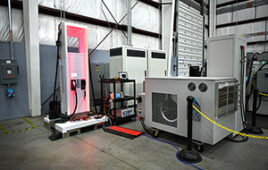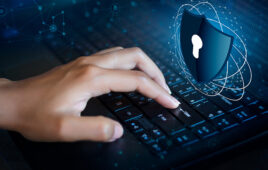 BLUFFDALE, Utah — The nation’s new billion-dollar epicenter for fighting global cyberthreats sits just south of Salt Lake City, tucked away on a National Guard base at the foot of snow-capped mountains. The long, squat buildings span 1.5 million square feet, and are filled with super-powered computers designed to store massive amounts of information gathered secretly from phone calls and emails.
BLUFFDALE, Utah — The nation’s new billion-dollar epicenter for fighting global cyberthreats sits just south of Salt Lake City, tucked away on a National Guard base at the foot of snow-capped mountains. The long, squat buildings span 1.5 million square feet, and are filled with super-powered computers designed to store massive amounts of information gathered secretly from phone calls and emails.Two small, weathered signs in the sagebrush greet interlopers to this place with a stark warning: “Military reservation. No trespassing.” But there is no visible marker bearing the facility’s name and operator: The Utah Data Center, brought to you courtesy of the National Security Agency.
When it opens this fall, the facility will be the NSA’s largest data storage center in the U.S. Just don’t ask Utah officials, and certainly not the residents of tiny Bluffdale, just north of the new center, to tell you exactly what will go on inside. They either don’t know, or aren’t saying. And the NSA is famously tight-lipped.
“We know it’s a spy center. But who are they spying on?” said Connie Robbins, an upholstery shop owner who lives in Bluffdale, a community of 8,000 some 25 miles south of Salt Lake City that is known for its rodeo and annual Old West Days.
The dearth of information has perpetuated a mystery that has spawned dozens of theories and a spoof website that even includes a phony code name for the facility: “Bumblehive,” a play on Utah’s nickname of the “Beehive State.”
Last week’s revelation that the NSA is collecting millions of U.S. phone records along with digital communications stored by nine major Internet providers illustrates how aggressively personal information is being congregated and analyzed — and shines a brighter light on what will be going on in secret at the Utah facility, scheduled to open in October.
NSA officials say the center will play a key role in the nation’s effort to protect national security networks, and allow U.S. authorities to monitor for potential cyberthreats. In an email, agency spokeswoman Vanee Vines said that “many unfounded allegations have been made about the planned activities” of the center.
“NSA would like to confirm, on the record, that the Utah Data Center is a state-of-the-art data facility designed to support the U.S. intelligence community’s efforts to further strengthen and protect the nation. Its operations will be lawfully conducted in accordance with U.S. laws and policies,” Vines wrote.
She provided no additional details, however.
Richard “Dickie” George, who retired from the NSA in 2011 after 40 years, said the facility isn’t nearly as interesting or mysterious as some think. He calls it little more than a giant storeroom. Inundated with increasing volumes of secretly taped phone calls, intercepted emails and poached records of online purchases, the NSA needed a mega-warehouse to put it all, he said.
“It’s just a big file cabinet out in the Western area,” said George, once a senior technical leader at the agency. “There is no spying going on there.”
NSA agents elsewhere will comb through the data stored in Utah as the agency attempts to understand how terrorist groups operate and who plays what roles, George said. Emails, articles, websites and videos on the Internet may hold clues about such activities, he said.
James Bamford, the author of several books on the NSA who last year wrote about the Utah center in Wired magazine, asserts that the facility will serve as the central depository for everything the NSA intercepts, functioning as the agency’s “cloud.” Analysts at NSA headquarters at Fort Meade, Md., and other agency sites will be able to access the information by way of secure, fiber-optic cables, he said.
The mammoth center, which cost some $1.7 billion, will allow the agency to store more and, perhaps more importantly, keep information for much longer. Bamford theorizes the facility will be able to hold a so-called yottabyte of information, the largest measurement computer scientists have. A yottabyte is equal to 500 quintillion pages of text, said Bamford, who believes the Utah center will store those phone records NSA gathered from Verizon Communications.
“Every day you pick up a telephone and call your grandmother or call your sons and daughters and mothers and fathers and whoever, records of those calls will be all kept in there — and may be kept in there forever. Who knows?” Bamford said.
In response, NSA spokeswoman Vines stressed that the agency is not “unlawfully listening in on, or reading emails of, U.S. citizens.”
NSA officials have said the agency chose the Bluffdale location over 37 others because electricity is cheaper here, and land more easily available. The center will constantly use 65 megawatts of power — enough to power 33,000 houses.
The secrecy and security surrounding the facility are necessary because the center will store classified information, and the code-breaking and spying activities of its staff are also highly classified and a target for foreign spies, said a former U.S. intelligence official who spoke on condition of anonymity because the official was not authorized to discuss the program publicly.
The official said the Salt Lake City area is ideal because of a high concentration of Mormons who have served overseas missions and learned foreign languages. The NSA relies on non-English speakers to translate communications from around the world, and Utah provides a pool of employees that meets this need, said the official.
There is another facility in Utah where the NSA has analysts who translate intercepted communications, but there will be no such analysts at the Bluffdale center, the agency said. Most of the 150 to 200 workers instead will be technicians charged with keeping the power on and the computers chilled and working.
George said the agency probably doesn’t need to be as hyper-secretive as it is but said such precautions are meant to avoid letting slip any insight that could tip off terrorist organizations and those who may wish harm upon the United States.
“It’s just not in your best interest to be talking about what you are doing,” he said.
It’s that air of uncertainty that has unnerved residents who live and work near the facility, located on the Camp Williams National Guard base. Some worry the center could become a target of terrorists if it holds so much valuable information.
“Say they were collecting data somebody didn’t want, say a terrorist,” said Shannon Neilson, a convenience store manager whose house is just miles from the center. “What if that’s a target for a plane hitting that, destroying everything?”
Late last month, a ribbon-cutting ceremony was held at the center to mark work being finished on the exterior. The celebration, however, was closed to the public — an exclusive, invitation-only gathering that barred even the mayor of Bluffdale. The NSA also rejected a request by city officials to take a group of visiting Utah mayors on a bus tour of the outside of the facility. The agency said all tours — even of the exterior — are prohibited.
At the University of Utah in Salt Lake City, educators are creating a certificate program that they hope will produce students ready to work at big data centers such as the Bluffdale facility. The NSA helped reviewed the curriculum, offering suggestions, and plans to offer internships to students, said Valerio Pascucci, director of the Center for Extreme Data, Management, Analysis and Visualization.
The program is designed primarily for undergraduate students studying mechanical or electrical engineering and computer science. So far, the Utah Data Center has yet to post jobs, Valerio said. “We are building a new expertise that obviously is going to be in growing demand in the future,” he said.
Bluffdale City Manager Mark Reid said he hopes the NSA center serves as a magnet for other, privately run data centers to the area. Unlike the NSA facility, those would be required to pay property taxes. Reid will travel to a data center conference in Washington, D.C., this month to promote Utah’s cheap power and ideal workforce. But if attendees ask about the new NSA facility, he’ll be short on answers.
“I know very little,” Reid said. “We just deliver the water.”
Associated Press Intelligence Writer Kimberly Dozier contributed from Washington, D.C.
Copyright The Associated Press




